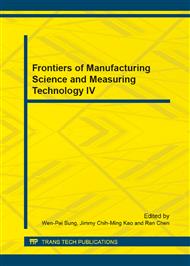[1]
Ruben H E, Michael P, Thomas S. Splitting Gaussian in Mixture Models. Pro of IEEE International Conference on Advanced Video and Signal Based Surveillance. Berlin, Germany, 2012: 300-305.
Google Scholar
[2]
Wenzhe Zhao, Shiyin Qin. Comparative Study on Detection Methods for Video Motion Targets, J. Science and Technology Review. 2009, 27(10): 64-70.
Google Scholar
[3]
Stauffer C, Grimson W E L. Adaptive background mixture models for real-time tracking. Pro of IEEE Computer Society Conference on Computer Vision and Pattern Recognition. MA, USA, 1999, 2(6), 23-25.
DOI: 10.1109/cvpr.1999.784637
Google Scholar
[4]
Kaewtrakulpong P, Bowden R. An improved adaptive background mixture model for real-time tracking with shadow detection. Pro of the Second European Workshop on Advanced Video Based Surveillance Systems. Kingston, UK, 2001: 149-153.
DOI: 10.1007/978-1-4615-0913-4_11
Google Scholar
[5]
Lee D S. Effective Gaussian mixture learning for video background subtraction. Pro of IE-EE Tran on Pattern Analysis and Machine Intelligence. CA, USA, 2005, 27(5): 827-832.
DOI: 10.1109/tpami.2005.102
Google Scholar
[6]
Bouttefroy P L M, Bouzerdoum A, Phung S L, et al. On the Analysis of Background Subtraction Techniques Using Gaussian Mixture Models. Proc of IEEE International Conference on Acoustics Speech and Signal Processing. Dallas, USA, 2010: 4042-4045.
DOI: 10.1109/icassp.2010.5495760
Google Scholar
[7]
Gorur P, Amrutur B. Speed up Gaussian Mixture Model algorithm for background subtraction. Proc of IEEE International Conference on Advanced Video and Signal Based Surveillance. Bangalore, India, 2011: 386-391.
DOI: 10.1109/avss.2011.6027356
Google Scholar
[8]
Mingzhi Li, Zhiqiang Ma, Yong Shan. Adaptive background update based on Gaussian mixture model under complex condition, J. Journal of Computer Applications, 2011, 31(7): 1831-(1935).
Google Scholar
[9]
Zivkovic Z, Improved adaptive Gaussian mixture model for background subtraction. Proc of International Conference on Pattern Recognition. Amsterdam Univ., Netherlands, 2004: 28-31.
DOI: 10.1109/icpr.2004.1333992
Google Scholar
[10]
WallflowerDataset[EB/OL]. http: /research. microsoft. com/en-us/um/people/jckrumm/WallFlo-wer/TestImage. htm.
Google Scholar
[11]
ChangeDetectionDataset[EB/OL]. http: /www. changedetection. net.
Google Scholar
[12]
ATONDataset[EB/OL]. http: /cvrr. ucsd. edu/aton/testbed.
Google Scholar


